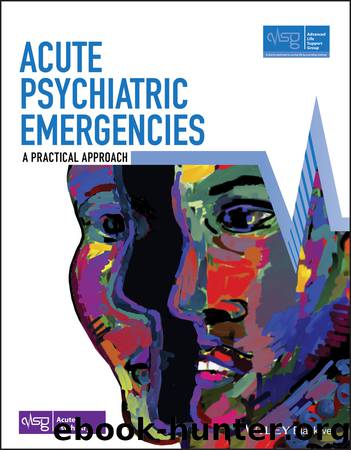Acute Psychiatric Emergencies by Advanced Life Support Group (ALSG)

Author:Advanced Life Support Group (ALSG)
Language: eng
Format: epub
ISBN: 9781119501084
Publisher: Wiley
Published: 2020-01-22T00:00:00+00:00
6.6 Case examples
Case 6.1
Tetsuya, a 57‐year‐old man, is brought into the ED by the police. Local supermarket staff contacted the police after members of the public expressed concerns that a man was locked in a toilet cubicle muttering to himself. Since arrival in the department he has been very anxious. It is difficult to follow his conversation, but he seems to be talking about being followed and also appears to be scared of the police officers accompanying him. He constantly asks passing staff if they can keep him safe and, although appropriately dressed, he is carrying a plastic bag which he is unwilling to put down. The police officers state that the bag contains paperwork including his passport.
Primary assessment ABCD A – Maintaining own airway
B – RR 18, SpO2 98%
C – HR 86 bpm, BP 135/85
D – Alert, PERLA, glucose 5.5 mmol/L AEIO A – Anxious and aroused, with possible delusional thoughts
E – In safe room. Police present
I – Not expressing any thoughts of wishing to harm himself. Not expressing an active wish to leave
O – No dangerous objects
Unified assessment and immediate treatment No immediate physical or mental health risk identified; no immediate physical treatment required; no rapid tranquillisation required
Containment plan to include discrete one‐to‐one security presence
Secondary assessment
Focused physical history and secondary examination A PHRASED physical history reveals no physical complaints except for mild hypertension (he has been non‐compliant with his antihypertensives recently as he has been too worried to pick up his prescription)
Physical examination is unremarkable, as are routine bloods and ECG
Focused conversational psychosocial history and mental state examination (MSE) Tetsuya believes that the government are following him using cars as well as spying on him with security cameras and electronic devices. He is unsure why they are doing this but believes that they wish to harm him in some way. He feels that he needs protection but is unsure who he can trust
Tetsuya denies a previous psychiatric history, but hospital records reveal he has had a previous admission on section 3 of the Mental Health Act (MHA) and has a diagnosis of schizophrenia. He was previously on a depot antipsychotic but appears to have disengaged from all follow‐up 6 months previously
He drinks 2 pints of lager on Friday, Saturday and Sunday evenings; no illicit substance use
MSE
A – Normal clothes
B – Constantly looking around and asking for protection
C – Distracted and unable to remember facts
S – Normal speech
M – Alert, anxious
I – No insight
T – Paranoid ideation
H – Hears voices warning him of danger
Disposal Tetsuya will need treatment for his psychotic illness and will require a MHA assessment
Reassess risks He will need security (one to one) in the department but at a discrete distance. Medications should be offered to help reduce his distress levels in the department although this may be refused. Should he become more aroused and agitated there may be a need for restraint and rapid tranquillisation
Case 6.2
24‐year‐old Naomi has been brought to the ED by her partner Emma after she had an argument with the neighbour. Naomi became uncharacteristically verbally and physically threatening.
Download
This site does not store any files on its server. We only index and link to content provided by other sites. Please contact the content providers to delete copyright contents if any and email us, we'll remove relevant links or contents immediately.
Periodization Training for Sports by Tudor Bompa(7916)
Why We Sleep: Unlocking the Power of Sleep and Dreams by Matthew Walker(6352)
Paper Towns by Green John(4790)
The Immortal Life of Henrietta Lacks by Rebecca Skloot(4253)
The Sports Rules Book by Human Kinetics(4077)
Dynamic Alignment Through Imagery by Eric Franklin(3919)
ACSM's Complete Guide to Fitness & Health by ACSM(3823)
Kaplan MCAT Organic Chemistry Review: Created for MCAT 2015 (Kaplan Test Prep) by Kaplan(3800)
Introduction to Kinesiology by Shirl J. Hoffman(3626)
Livewired by David Eagleman(3534)
The River of Consciousness by Oliver Sacks(3417)
The Death of the Heart by Elizabeth Bowen(3336)
Alchemy and Alchemists by C. J. S. Thompson(3294)
Descartes' Error by Antonio Damasio(3164)
Bad Pharma by Ben Goldacre(3095)
The Emperor of All Maladies: A Biography of Cancer by Siddhartha Mukherjee(2928)
The Gene: An Intimate History by Siddhartha Mukherjee(2927)
The Fate of Rome: Climate, Disease, and the End of an Empire (The Princeton History of the Ancient World) by Kyle Harper(2870)
Kaplan MCAT Behavioral Sciences Review: Created for MCAT 2015 (Kaplan Test Prep) by Kaplan(2815)
